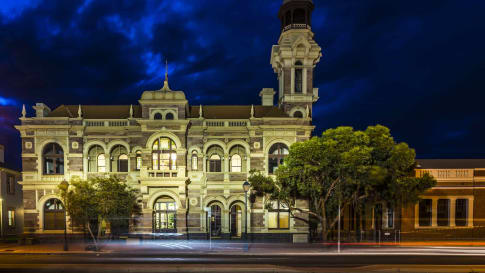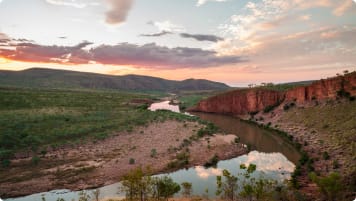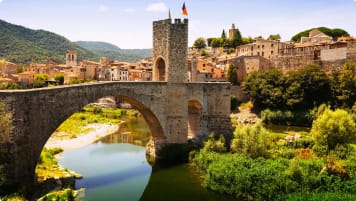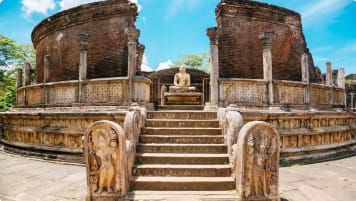Small group tour; Broken Hill and back
Small group tour of New South Wales, Queensland & South Australia deserts, from Broken Hill. Learn about the history of the people who explored the deserts, from indigenous communities to Europeans, as well as Burke and Wills, visit White Cliffs, Birdsville, Maree.
From A$11,550AUD
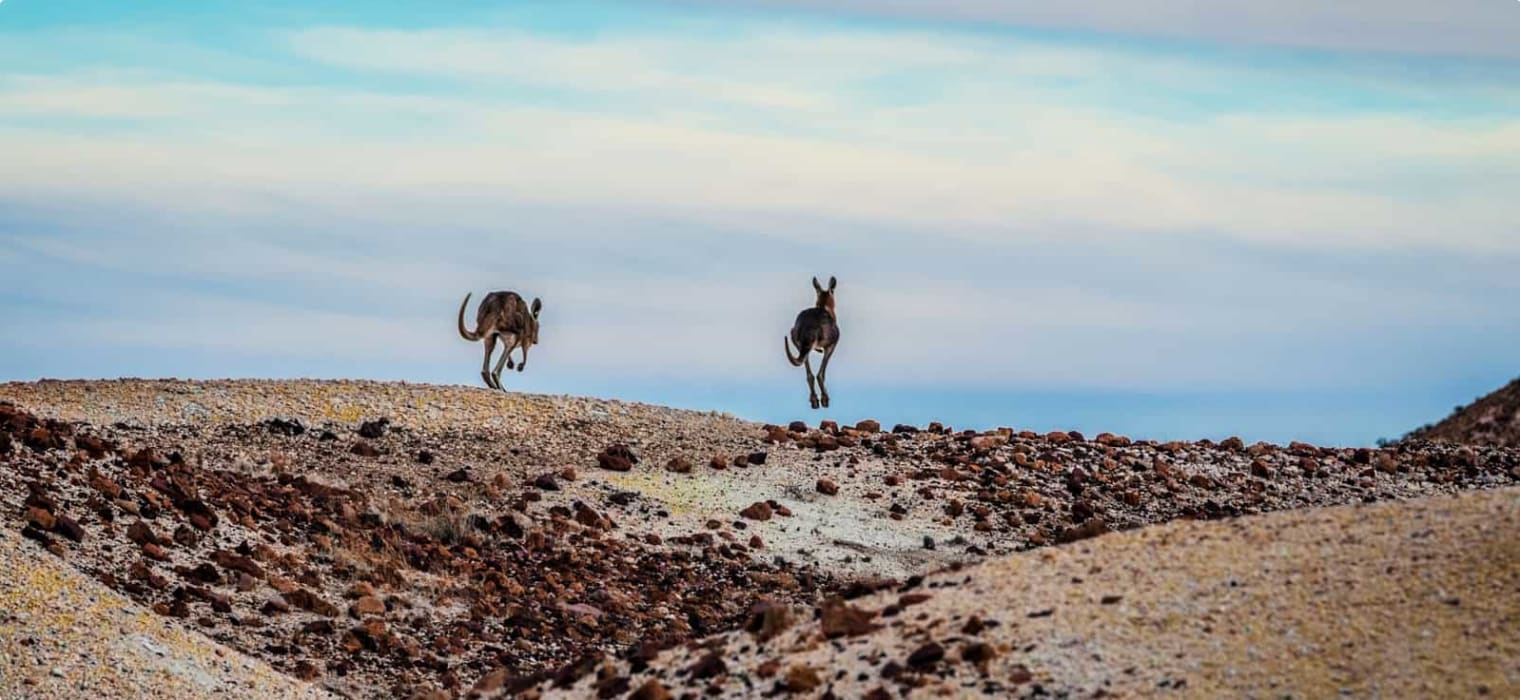
Highlights
- 1. Learn about the history of Broken hill and Silverton.
- 2. Reach the infamous Cameron corner, the junction of the 3 states.
- 3. Learn about Pro Hart and the brushmen of the bush view of the landscape.
- 4. Understand the importance of the 10 desert program as you travel through the deserts of Sturt and Strzelecki.
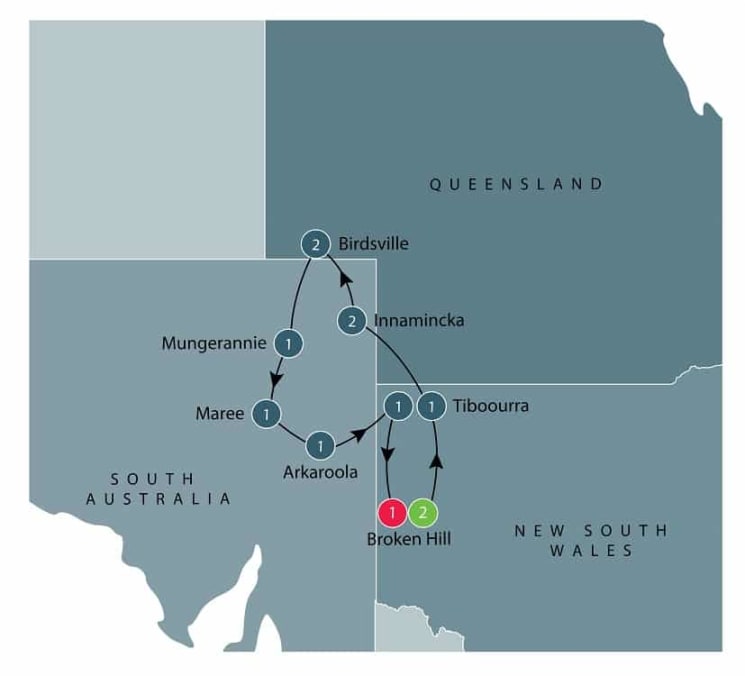
Departure Dates
| Departure Date | Price |
|---|---|
| 24 March 2025 Ends 05 April 2025 • 13 days A$12,100 Twin A$13,850 Single Available | Selected |
| 13 October 2025 Ends 25 October 2025 • 13 days A$12,100 Twin A$13,850 Single Available |
Small group Australian outback tour to Broken Hill and back
Broken hill tours for a small group outback Australia tour for senior and mature travellers to Broken Hill and back limited to 12 people, a mix of couples and solo travellers.
These off the beaten track small group outback Australia Broken hill tours that enable the traveller to journey deep into the outback NSW on a 13 day 3,200 kilometre round trip, tri state safaris, that begin and end in Broken Hill , or 'The Silver City'. This small group tour of the Australian outback tracks on North, just over in the Queensland border, up to Birdsville then goes deep into outback South Australia, before heading up to Cameron Corner, corner country. Cameron corner is unique, it is the junction of the three states: New South Wales, Queensland, and South Australia. This small group outback tour from Cameron corner heads south from here returning to Broken Hill.
This, like all Odyssey Traveller small group tours is limited to 12 people.
The Aboriginal community have occupied and transited across this part of central outback Australia for up to 60,000 years. The Europeans a little over 200 years, the duration of occupation speaks for itself as it does in so many of Odyssey Travellers small group outback Australia tours within each state. During this 13 day itinerary this small group Australian outback tour will meet and learn from Aboriginal guides and see some of the key places that the indigenous community are ready to share about Aboriginal culture to extend your understanding of this unique region and your outback experience.
These Australian outback tours also explore and learn about the importance of the National park network and its unique endemic biodiversity. And finally the Australian outback tours itinerary means we stop at places of importance in the European history of Australia, primarily the outback adventure that was the catastrophic Burke and Wills expedition out of Melbourne and the mapping work of Charles Sturt and his search for the "inland sea". By the time this guided tour returns to Broken Hill our appreciation and understanding of this part of the central outback Australia will have been extended as a result from what we have heard from the expert custodians in Aboriginal culture in the indigenous community and local guides who have a perspective and respect for the European history of the last two centuries.
Because of the intensity of the environment that these outback Australia tours travels through, Odyssey Traveller offers just a maximum of four departures a year in the Spring and Autumn.
Group size on these outback Broken hill tours is limited to 15 participants.
Broken Hill (Silver city)
After meeting the night before as a small group tour, we spend today exploring and learning about Broken Hill or Silver city as it is often referred too, beyond being a mining town defined by its historic building collection and iconic broken hill cemetery. A town on the edge of the desert with a unique mix of Aboriginal culture, desert landscapes that stretch forever, movie locations, mining experiences, and contemporary art galleries. Prior to the Europeans arriving, this part of the outback for some 60,000 years had been occupied at times by the Wiljali Aboriginal people.
The group's day tour of Broken hill, which was named by Charles Sturt, begins with a walking tour in the morning of Argent Street, Broken Hill's Main Street. Here Government influenced Architectural design from the Victorian period reigns, from the courthouse to the post office. The group gains an appreciation of the transformation from wild west mining to organised unionists managing the town.
Your tour guide explains that Broken hill has its share of quirks, maybe more so than other places, including a memorial to the orchestra who sank whilst playing on the Titanic. There is no relationship to any member to the Titanic, just the town band thought it would be a nice thing to do! We spend some time visiting the mining museum but what is also important gain an appreciation of the collective work of the "Brushmen of the Bush" so that as we travel into the landscape of the desert, the eye has an appreciation and understanding of this group of Artists.
To achieve this, we visit some of the key galleries in Broken Hill and enjoy short talks from the curators. Broken Hill has more art galleries than any other inland town or city in Australia as well as a strong Regional Art Gallery with works by Charles Blackman, Arthur Boyd, Clifton Pugh, and Lloyd Rees to view. Broken Hill's European artistic heritage started in the 1960s when a group of self-taught artists led by Pro Hart caught the imagination of the public. Pro Hart championed a group of local, vernacular artists who became known as the "Brushmen of the Bush".
Later in the afternoon we drive out to Silverton a lapsed mining town, and now a film set for many films including Mad Max, it is locked in time and the horses roam the streets. The group after Silverton drive up to the spectacular Mundi Mundi lookout, here Australia and the world roll away underneath you and go on for what seems to be forever, big skies and big landscape! We would seek to visit the Mundi Mundi lookout, timing permitting at close to sunset. Tomorrow, we have our first full day of touring into the Outback as we go to Tibooburra via Menindee and White Cliffs.
Tibooburra via Menindee and White Cliffs
On this small group Australian outback tour there is a sense as we travel that the explorers from Melbourne, which is a generous term, Burke and Wills are seemingly close throughout our journey. Our itinerary may seem slightly unusual, but then so was Burke & Wills appointment as the people to traverse Australia and the journey they made to attempt to traverse this continent.
We leave Broken Hill smartly in the morning to travel to Menindee, as well as visiting White Cliffs on our journey to Tiboourra. Menindee is a tiny outback settlement famous for two things: it was the last place where the Burke and Wills expedition stayed before heading north into the unchartered outback and the Menindee Lakes are an inland wonderland and a vital source of water for the surrounding citrus orchards and vegetable farms.
Menindee is on the northern fringe of the New South Wales mallee country. ‘Mallee woodlands’ have been listed by the Australian Department of Environment and Energy as one of the 32 ‘Major Vegetation Groups’ of Australia. Mallee country is defined by the predominance of the mallee eucalyptus, a stocky eucalyptus with several stems, which grows on semi-arid soil. Mallee country spreads in a belt across the south of Australia, centring around the Murray River in western Victoria and eastern South Australia, the Eyre Peninsula west of Adelaide, and the 'wheat belt' of Western Australia. Though European settlers found the Mallee an inhospitable country, Aboriginal peoples have successfully lived in the area for over 40, 000 years.
Menindee is surrounded by lakes in an inhospitable desert and mallee environment! About 20 km north of Menindee on the shores of Lake Menindee is the amusingly named Sunset Strip. This small holiday community on the shore of the lake is made up mostly of inexpensive holiday homes. Many of the gardens are well-irrigated and most of the houses are on the shoreline, this is a weekend getaway for the people of Broken Hill.
The group pauses before reaching Menindee to walk round the Kinchega Station Homestead Site, this was a huge sheep farm before becoming a National Park. A one-million-acre farm for some 90 years, shearing some 6 million sheep in its time, this was a large sheep farm in the 1880's. Menindee became an important river port and telegraph station. The boats were quicker and much cheaper than bullock trains to get the wool clip to Port Augusta. However, when gold was found to the north in the late 1870s labourers and station workers along the Darling river left their jobs in their quest for gold. This resulted in Wilcannia some 60km's on becoming the main river port in the region rather than Menindee. The group stops in Menindee and has a short walking tour of the settlement, listening to some of the Historic stories including those of Burke & Wills and their piano for example. Burke and Wills reached Kinchega station in October 1860 and stayed at the Menindee hotel.
After the walking tour of Menindee, the group resumes it journey to White Cliffs for lunch. White cliffs is about Opals, over 50,000 holes have been dug looking for them.
White Cliffs is an underground mining town solely here to hunt for Opals. This is an extremely hot part of Australia, the few residents left live in underground chambers, though the post office is built of corrugated iron in full sun! It is an unusual place complete with Opal stores and a population of cave dwellers. It draws a larger population in the winter months and a house made of beer bottles is a national attraction! We leave White Cliffs and the group continues on through the outback to Tibooburra where we pause for the day.
Time and the archaeological record of human activity is incredible. The period of human habitation and activity prior to the arrival of the Europeans is to be respected. Archaeologists readily can go back up to 25,000 years of the 40,000 with ease.
For 25,000 years prior to the arrival of Europeans the Wangkumara and Malyangapa Aboriginal people moved through the area of Tibooburra. Archaeologists have identified Middens, quarries, camp sites, ceremonial sites, tool production sites and scarred trees still exist as evidence of Aboriginal occupation. In 1845 Charles Sturt and his party (there were 16 men, 11 horses and 30 bullocks) reached the area. Charles Sturt and his support team complete with a boat were trying to discover an inland sea. In 1860 Burke and Wills passed through the area on their ill-fated journey from Menindee to the Gulf of Carpentaria. With all this history there is another key attraction and that is the mural in the Family hotel in Tibooburra.
In the 1960s three artists - Clifton Pugh (famous for his portrait of Gough Whitlam which now hangs in the National Portrait Gallery), Russell Drysdale (one of the country's most important painters of rural life) and Rick Amor took a trip to Tibooburra to paint the outback. They stayed at the Family Hotel and during their stay they painted murals on the walls. The most famous is the large mural painted by Clifton Pugh which takes up an entire wall beside the bar. Over the years other artists have added to the artwork so that the pub is now a very special kind of outback art gallery.
Depending on timings there may be the opportunity to take a trip to the Historic Mount Wood Homestead located on the oldest sheep station in northwest NSW, taken up around 1881. Listed on the State Heritage Register, it is one of the most complete examples of a self-reliant sheep station in the region, spanning 368,385 acres. It was a hub for washing sheep wool on the long journey by camel train or cart to Wilcannia, prior to shipping. We passed through Wilcannia yesterday on our way to White Cliffs!
Innamincka
When we leave Tibooburra this Australian outback tours small group will pause in the desert to view the ancient landforms that are known as the Jump-Ups are the remains of an ancient mountain range that have been eroded down over millions of years leaving the 150m plateau (Mesa) and the granite strewn plains. This is part of the Charles Sturt National Park we pass through this morning. We cross into Queensland at the Warri Gate. The gate forms part of the longest fence in the world in an attempt to manage Dingoes and rabbits... The tour now enters some incredible desert landscapes, it is out here that Burke and Wills met their fate on the riverbank at Cooper Creek. We do visit the infamous dig tree and can reflect on how different the outcome might have been for this group of explorers if time had accelerated by 7 hours.
Tomorrow we see the dune formations of the Strzelecki Desert on our way from Innamincka to the National Park. The group learns about the 10 desert project. The 10 Desert Project is the largest connected network of protected areas in the world with 173 areas recognised as a part of the National Reserve System and is the largest network of Indigenous-managed lands in the world with a total of 21 Indigenous Protected Areas.
The project provides a unique opportunity to demonstrate collective action to build environmental resilience at an unprecedented scale worldwide, led by Indigenous organisations with the support of external stakeholders. Strategic collaborations and coordinated responses to key threats are transformational in assisting Indigenous organisations to develop new and creative responses to challenges of low capacity and landscape scale management across this central part of the outback.
Extending across ten deserts, these globally significant arid lands are home to an exceptional diversity of animals and plants including over 80 threatened plants and animals (such as bilbies and rock wallabies). The area also has immense cultural value largely as a result of 50,000 years of continuous occupation by Indigenous people. Despite being relatively intact, these unique desert ecosystems and the values they contain are under increasing threat due to inadequate resources for land management activities, invasive exotic weeds and introduced pests, changed fire regimes, climate change and the movement off country over the past 150 years of the lands’ traditional custodians. This is an exciting project, with an opportunity to hear from some of the rangers who are involved in this land management program. The 10 deserts project is a substantial land management project reflecting the world within the world of Australia beyond the cities we occupy. It is inspiring to learn that such initiatives are taken place to protect these vast areas of land that have been managed sustainable for some 50,000 years by the collective working of the traditional owners.
The small group tour also visits Coongie Lakes which is listed as a Ramsar Wetland of International Importance . This is like a UNESCO World heritage site but for Wetlands. The group learns why the wetland is so crucial to the local ecosystems as well as the importance of this area to the local indigenous community, the Ngarrindjeri. The Ngarrindjeri community continue to take a leading role in the management of the region, including Coorong National Park and the management of its connected waters. Their presence represented often by archaeological sites with ancient mounds of discarded shells mark the Ngarrindjeri people’s presence in the region for some 40,000 year.
At Coongie Lakes the waterbird diversity is high for an arid wetland and is a significant feeding, resting, and breeding site for an enormous number of birds that migrate to the area. The wetland plays host to a diversity of wildlife including fish, reptiles, and frogs. It transforms into a breeding ground for an enormous number of migratory birds from around the world. The contrast from sand dunes to vast wetlands is remarkable. The best times to explore and observe wildflowers and the wildlife are April and October which is typically when Odyssey schedules its outback tours to the region.
At the end of the day back in Innamincka there is an opportunity to take a trip with a local tour guide from the pub along Coopers Creek to look at the native wildlife along the creek edge.
On to Birdsville, QLD
The desert rolls by as we have a long day heading to for two nights in Birdsville, QLD. However, our appreciation of the landscape, shaped by our study of Pro Hart and his posse of Brushmen's interpretation of the landscape and now the cultural land management of the 10 deserts program continues to evolve into almost awe at the decision to extract a living from such an arid environment, that takes many of us outside our regular comfort zone. It is not just what we have seen that does this to us but the stories we have heard to date of history and also land management. When we search on the web for Strzelecki, as a curiosity for the name associated with the desert, Paul Strzelecki is returned, a Polish born explorer who explored much of New South Wales and Tasmania whilst these areas where still in their infancy of being explored by Europeans. Strzelecki reached this part of central Australia in his travels on foot and was recognised with this desert named after him by Charles Sturt. Strzelecki was busy in his time in Australia and is possibly unique as an explorer with the amount of ground covered and papers written. Strzelecki, waked and walked across the desert explored the Illawarra and found time to climb and name Mount Kosciuszko. after a polish man, in Victoria. There are accolades from Charles Darwin on Strzelecki's work and curiosities raised on his research in the Illawarra and questions as to why on his death in London age 77, his wished was to have all his paper burnt...
Anyway, this region forms some of the driest parts of Australia, the Sturt Stony Desert is believed to an ancient seabed, eroded by the wind. The erosion creating the unusually sharp undulating exposed rock forms that make the passage very difficult off road. We pass across the desert landscapes to reach Hadden corner, the boundary of Queensland and South Australia. Historically important for taxation... but the oddest thing is though, that out here beneath this ancient landscape, commercial gas is extracted and delivered to Adelaide, released via fracking the shale some 3.5km below the surface, today the gas is transported by pipe to Adelaide from Moomba.
But today if you think this has been an outback adventure, before the group arrive in Birdsville for two days we pause in the ghost town of Betoota QLD (population One) at the pub. Betoota was originally a customs post to collect tolls for stock as they travelled to South Australia. It was also a Cobb & Co stagecoach change station. Collecting taxes for stock or the wool clip was always a bit of a game of hide n seek out here. Pastoralists would orientate themselves to where the tax was the lowest eventually forcing consistency between the states.
After Beetota we then continue on for the last 170 kms to Birdsville where we stay for two nights. As we travel out of Betoota this escorted group tour stops to view aboriginal rock art, a Dreamtime serpent on the side of a low-rise hill formed by the traditional Owners of the land, the Mithika People.
The Betoota Serpent is a work of aboriginal rock art representing a series of pathways travelled through Country to connect the river systems in the Channel Country of the Diamantina river region. The Serpent has been created using gravel and gibbers found throughout the shire. Gibbers are used in the two circles one at the rainbow serpents head and another circle at the tail at the other side of the hill. Gibbers were traditionally used to mark the land re used to for direction to guide people to land points as well as used for tools and to create stories to become pictures within the landscape. As we travel through the region, we will see several Dreamtime serpents in the landscape.
Birdsville
Birdsville, population 100, down from 5,000 is a resting point for the group. The local indigenous community passed through the area, Sturt did, and Burke and Wills passed nearby... But this is a spot that a decision was made to intersect some roads including the Birdsville Track, a track etched out of the landscape for drovers moving Cattle, a community formed around this rest stop and watering hole for cattle drovers moving their stock to take a break.
This small group tour of the Australian outback spends the day touring around the area of Birdsville. Once again there is something unique and that few people get to see even out here Kilometres from anywhere. We visit the stand of rare Waddi trees, one of only three such stands left in Australia and all are in the desert along water courses. Members of the Acacia family, these trees may live for around thousand years. There is a conservation program and the decline, reflects the loss of habitat. The timber that is so hard it can damage an axe. We stop at the edge of the Simpson Desert and the "Big red sand dune" before returning to Birdsville.
The group also stops at "The Burke and Wills Tree", part of the famous Burke and Wills expedition story from the 1800's. This Coolabah Tree is situated on the banks of the Diamantina River, three kilometres from Birdsville. The tree was marked by Burke and Wills during their expedition with the letter 'B' and the camp number '76', although it was later marked “BW-C76 1860” by travellers retracing the expedition. The tree is said to mark one of their final campsites before they reached the Innamincka area, where the famous Dig Tree stands. We carry on to town and pause at the infamous Birdsville racetrack and then return to take a walk around the town learning about the European history of Birdsville.
We visit the second of the three aboriginal rock art Dreamtime Serpents, designed by members of the native Wangkangurru/ Yarluyandi tribe as a directional marker for travellers.
The Birdsville Track to Maree
Today we leave the most Northerly point of this escorted small group adventure and turn South. Over the next 2 days we follow the Birdsville track, first through the Simpson Desert now known as Munga-Thirri National Park , it is Queensland’s largest protected area and covers nearly a million hectares and then the Sturt stony desert. You will recall the importance of these deserts as part of the 10 desert project.
The Birdsville track opened in the 1860s to walk cattle from northern Queensland and the Northern Territory to the nearest railhead in Port Augusta which was later moved to new rail head at Marree. The pioneering drover who is credited with establishing the track was Percy Burt. Burt set up a store at Diamantina Crossing, today known as Birdsville, and used the path to bring cattle out of the Channel Country to the railhead at Marree that was completed in 1883. This stock route was at least 1000 km shorter than the alternative path to Brisbane. By 1916, 50 years after the track begun as a cattle route, enough bores had been sunk into the Great Artesian Basin along the route that the movement of stock was much easier and safer than in earlier years. Water bores were drilled at 40km intervals.
Today we complete half of the Birdsville track pausing to rest at the Mungerannie Hotel. It will not be hard after the last few days out here in the outback to squint and think of man and horse and cattle in this arid landscape being guided and worked their way south along the track to the rail head! Heat, noise, dust, fatigue of man and animal to make the journey to sell the stock. And to then must make the return journey along the same track.
Today the group has a 200km drive today to Maree, crossing through the Titari Desert. Geological analysis revivals the sandstone of the desert is part derived from Antarctica; this is old geologically material. We cross Coopers creek, the creek associated with the death of Burke & Wills over towards Innamincka.
Maree
Marree is a historic watering hole and the head of the railway that runs to Port Augusta, Australia's crossroads with ships waiting to load up and sail to all ports around the world. town on the edge of the vast desert area of Central Australia. To the north lie the Simpson Desert and Sturt's Stony Desert and to the north-east is the Strzelecki Desert. The vast saltpan, Lake Eyre, lies to the northwest. Marree is a true desert settlement receiving an average annual rainfall of only 125 mm. There is little here today, once a bustling settlement with Aghani camel drivers, camels, trains, and all the activity of busy rail head. Afghan camel drivers established a base at the settlement from which they headed to Oodnadatta, Birdsville and Alice Springs and camels remained here until the late 1940's.
After breaking for lunch, we call at the Park museum complete with mail, van, see the replica mosque. Tomorrow we take a trip through to Arkaroola.
Arkaroola Village and Wilderness sanctuary
The Arkaroola Wilderness Sanctuary is a privately-owned 610 square kilometre (236 square mile) wilderness sanctuary at the far northern tip of the Flinders Ranges National Park which is our destination today. The scenery is impressive: soaring granite peaks, deep gorges, and waterholes - and the sanctuary is one of the best places to see the rare yellow-footed rock wallaby. On our visit, a local guide will share with the group the diversity of plants and animals observed, discussing those that are rare and endangered and their conservation within the network of Flinders Ranges National Parks . We spend the afternoon and early evening/twilight with a local tour guide learning about the unique animals in sanctuary and area.
Arkaroola to Tiboourra
Today is a solid drive back through the Strzelecki Desert and along the Strzelecki Track that we meet about 180 km from Arkaroola to Cameron's corner.
To reach the point where the three states meet (South Australia, Queensland and New South Wales) we take the Merty Track to Cameron Corner or ‘The Corner’ as it is affectionately known and from here we head onto Tiboourra. Cameron's corner is named after the NSW surveyor, John Cameron, Cameron Corner was marked in 1879 with the help of Queensland surveyor George Watson. It is a busy tourist stop sitting on the edge of the Sturt National Park - people make tri state safaris just to say they have seen it. A single post marks the spot. After lunch, we continue on to Tibooburra for the night.
Tiboourra has a population of 134+/- in this desert location, the gold rush is long over and the group has a second chance to explore this historic community before returning to Broken hill the following day for our final day of this small group tour. We stop at Depot Glen near Milparinga. Depot Glen, is where Sturt abandoned the 30-foot, 12-oar whaler boat that had been brought with the expedition on his search for the inland sea. Depot Glen is s a water hole on Preservation Creek, it was here that Sturt and his party were forced to camp for six months. They had arrived in the area during a severe drought and could not proceed because of lack of water. Charles Stuart was a member of Sturt's expolring party who went on later to traverse Australia south to North.
To the north of Depot Creek, 16km's away is the lonely grave of James Poole, Sturt's second-in-command, who died of scurvy. The party buried him under a grevillea tree, carving his initials and the year 1845 into the tree, which still stands. There is also a memorial headstone.
After Depot Glen, and if staff available we stop at Fowlers Gap Research Station to hear about the function of the Station. Fowlers Gap is more than 100 kilometres from the nearest town and the only research station in the arid zone of New South Wales. The University of New South Wales owns the 39,000-hectare property and frequently hosts groups of scientists, artists and school children who travel hundreds — in some cases tens of thousands — of kilometres to study the unique flora and fauna.
After this stop we carry on to Broken hill, for our last evening together on this touring program.
For all the articles Odyssey Traveller has published for mature aged and senior travellers, click through on this link .
Odyssey Traveller acknowledges Aboriginal and Torres Strait Islander peoples as the First Australians and Traditional Custodians of the lands where we live, learn and work. We pay our respects to Elders past, present, and emerging.
Articles about Australia published by Odyssey Traveller:
- The Kimberley: A Definitive Guide
- Uncovering the Ancient History of Aboriginal Australia
- Aboriginal Land Use in the Mallee
- Understanding Aboriginal Aquaculture
- Mallee and Mulga: Two Iconic and Typically Inland Australian Plant Communities (By Dr. Sandy Scott).
- The Australian Outback: A Definitive Guide
For all the articles Odyssey Traveller has published for mature aged and senior travellers, click through on this link.
External articles to assist you on your visit to Broken Hill and Back
Gallery
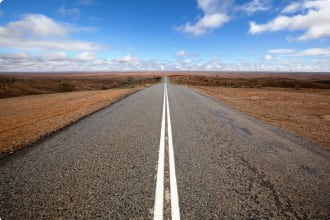
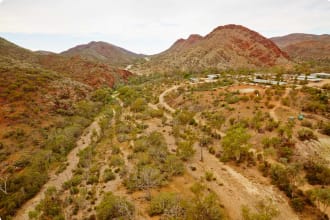
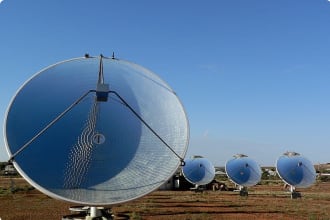

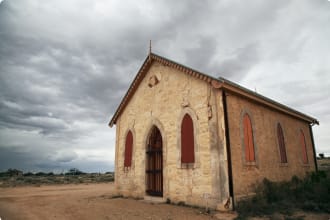

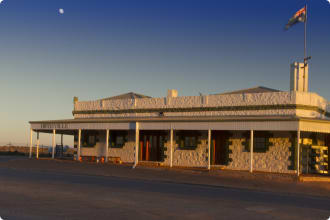
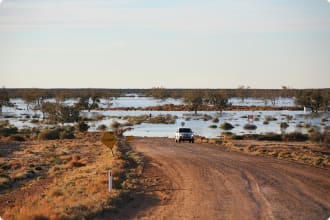

Itinerary
13 days
Day 1: Broken Hill
Accommodation: Broken hill- TBA
The group comes together in the late afternoon for a tour briefing and introductions. There is a welcome dinner this evening.
Day 2: Broken Hill
Accommodation: Broken hill- TBA
The group’s day tour of Broken hill, which was named by Charles Sturt, begins with a walking tour in the morning of Argent Street, Broken Hill’s Main Street with a local guide. Here Government influenced Architectural design from the Victorian period reigns, from the courthouse to the post office. The group gains an appreciation of the transformation from wild west mining to organised unionists managing the town.
We spend some time visiting the mining museum but what is also important gain an appreciation of the collective work of the “Brushmen of the Bush” so that as we travel into the landscape of the desert, the eye has an appreciation and understanding of this group of Artists.
To achieve this, we visit some of the key galleries in Broken Hill and enjoy short talks from the curators. Broken Hill has more art galleries than any other inland town or city in Australia as well as a strong Regional Art Gallery with works by Charles Blackman, Arthur Boyd, Clifton Pugh, and Lloyd Rees to view.
Later in the afternoon we drive out to Silverton a lapsed mining town, and now a film set for many films including Mad Max, it is locked in time and the horses roam the streets. The group after Silverton drive up to the spectacular Mundi Mundi lookout, here Australia and the world roll away underneath you and go on for what seems to be forever, big skies and big landscape! We would seek to visit the Mundi Mundi lookout, timing permitting at close to sunset.
Day 3: Tiboourra
Accommodation: Tiboourra-TBA
Today we have our first full day of touring into the Outback as we go to Tibooburra via Menindee and White Cliffs.
About 20 km north of Menindee on the shores of Lake Menindee is the amusingly named Sunset Strip. This small holiday community on the shore of the lake is made up mostly of inexpensive holiday homes. Many of the gardens are well-irrigated and most of the houses are on the shoreline, this is a weekend getaway for the people of Broken Hill.
The group pauses before reaching Meinidee to walk round the Kinchega Station Homestead Site, this was a huge sheep farm before becoming a National Park. A one-million-acre farm for some 90 years, shearing some 6 million sheep in its time, this was a large sheep farm in the 1880’s. Menindee became an important river port and telegraph station.
The group stops in Menindee and has a short walking tour of the settlement, listening to some of the Historic stories including those of Burke & Wills and their piano for example. Burke and Wills reached Kinchega station in October 1860 and stayed at the Menindee hotel.
After the walking tour of Menindee, the group resumes it journey to White Cliffs for lunch. White cliffs is about Opals, over 50,000 holes have been dug looking for them. We leave White Cliffs and the group continues on through the outback to Tibooburra where we pause for the day.
This is where Burke & wills passed through, as well as Charles Sturt plus another key attraction and that is the mural in the Family hotel in Tibooburra.
In the 1960s three artists – Clifton Pugh (famous for his portrait of Gough Whitlam which now hangs in the National Portrait Gallery), Russell Drysdale (one of the country’s most important painters of rural life) and Rick Amor took a trip to Tibooburra to paint the outback. They stayed at the Family Hotel and during their stay they painted murals on the walls.
Day 4: Innaminka
When we leave Tibooburra this Australian outback tours small group will pause in the desert to view the ancient landforms that are known as the Jump-Ups are the remains of an ancient mountain range that have been eroded down over millions of years leaving the 150m plateau (Mesa) and the granite strewn plains. This is part of the Charles Sturt National Park we pass through this morning.
We cross into Queensland at the Warri Gate. The gate forms part of the longest fence in the world in an attempt to manage Dingoes and rabbits… The tour now enters some incredible desert landscapes, it is out here that Burke and Wills met their fate on the riverbank at Coopers creek. We do visit the infamous dig tree and can reflect on how different the outcome might have been for this group of explorers if time had accelerated by 7 hours.
Day 5: Innaminka
Accommodation: Innaminka-TBA.
This small group continues further into the outback. We see the dune formations of the Strzelecki Desert on our way from Innamincka to the National park. The group learns about the 10 desert project from a local guide. The 10 Desert Project is the largest connected network of protected areas in the world with 173 areas recognised as a part of the National Reserve System and is the largest network of Indigenous-managed lands in the world with a total of 21 Indigenous Protected Areas.
The small group tour also visits Coongie Lakes which is listed as a Ramsar Wetland of International Importance . This is like a UNESCO World heritage site but for Wetlands. The group learns why the wetland is so crucial to the local ecosystems as well as the importance of this area to the local indigenous community, the Ngarrindjeri. At Coongie lakes the waterbird diversity is high for an arid wetland and is a significant feeding, resting, and breeding site for an enormous number of birds that migrate to the area.
We arrive in Innaminka in the very late afternoon.
Day 6: Birdsville
Accommodation: Birdsville-TBA.
The desert rolls leaving Innaminka as we have a long day heading to for two nights in Birdsville, QLD. However, our appreciation of the landscape, shaped by our study of Pro Hart and his posse of Brushmen’s interpretation of the landscape and now the cultural land management of the 10 deserts program continues to evolve into almost awe at the decision to extract a living from such an arid environment, that takes many of us outside our regular comfort zone.
Anyway, this region forms some of the driest parts of Australia, the Sturt Stony Desert is believed to an ancient seabed, eroded by the wind. The erosion creating the unusually sharp undulating exposed rock forms that make the passage very difficult off road. We pass across the desert landscapes to reach Hadden corner, the boundary of Queensland and South Australia.
We pause in the ghost town of Betoota QLD (population One) at the pub. Betoota was originally a customs post to collect tolls for stock as they travelled to South Australia. It was also a Cobb & Co stagecoach change station.After Beetota we then continue on for the last 170 kms to Birdsville where we stay for two nights. As we travel out of Betoota this escorted group tour stops to view aboriginal rock art, a Dreamtime serpent on the side of a low-rise hill formed by the traditional Owners of the land, the Mithika People.
Some 160 kms after Betoota, we arrive in Birdsville.
Day 7: Birdsville
Accommodation: Birdsville-TBA.
This small group tour of the Australian outback spends the day touring around the area of Birdville. Once again there is something unique and that few people get to see even out here Kilometres from anywhere. We visit the stand of rare Waddi trees, one of only three such stands left in Australia and all are in the desert along water courses. Members of the Acacia family, these trees may live for around thousand years. There is a conservation program and the decline, reflects the loss of habitat. The timber that is so hard it can damage an axe.
The group also stops at “The Burke and Wills Tree”, part of the famous Burke and Wills expedition story from the 1800’s. This Coolabah Tree is situated on the banks of the Diamantina River, three kilometres from Birdsville. The tree was marked by Burke and Wills during their expedition with the letter ‘B’ and the camp number ’76’.
We stop at the edge of the Simpson desert and the “Big red sand dune” before returning to Birdsville. We pause at the infamous Birdsville racetrack and then return to take a walk around the town learning about the European history of Birdsville. We visit the second of the three aboriginal rock art Dreamtime Serpents, designed by members of the native Wangkangurru/ Yarluyandi tribe as a directional marker for travellers.
Day 8: Mungerannie Hotel
Accommodation: Mungerannie Hotel
Today we leave the most Northerly point of this escorted small group adventure and turn South. Over the next 2 days we follow the Birdsville track, first through the Simpson Desert now known as Munga-Thirri National Park , it is Queensland’s largest protected area and covers nearly a million hectares and then the Sturt stony desert. You will recall the importance of these deserts as part of the 10 desert project.
Today we complete half of the Birdsville track pausing to rest at the Mungerannie Hotel.
Day 9: Maree
Accommodation: Maree - TBA
Today the group has a 200km drive today to Maree, crossing through the Titari Desert. Geological analysis revivals the sandstone of the desert is part derived from Antarctica; this is old geologically material. Marree is a historic watering hole and the head of the railway that runs to Port Augusta, Australia’s crossroads with ships waiting to load up and sail to all ports around the world. town on the edge of the vast desert area of Central Australia.
After breaking for lunch, we call at the Park museum complete with mail, van, see the replica mosque. Tomorrow we take a trip through to Arkaroola.
Day 10: Arkaroola
Accommodation: Arkaroola Wilderness Sanctuary
The Arkaroola Wilderness Sanctuary is a privately-owned 610 square kilometre (236 square mile) wilderness sanctuary at the far northern tip of the Flinders Ranges National Park which is our destination today. The scenery is impressive: soaring granite peaks, deep gorges, and waterholes – and the sanctuary is one of the best places to see the rare yellow-footed rock wallaby. On our visit, a local guide will share with the group the diversity of plants and animals observed, discussing those that are rare and endangered and their conservation within the network of Flinders Ranges National Parks . We spend the afternoon and early evening/twilight with a local tour guide learning about the unique animals in sanctuary and area.
Day 11: Tiboourra
Accommodation: Tibooburra-TBA
Today is a solid drive back through the Strzelecki Desert and along the Strzelecki Track that we meet about 180 km from Arkaroola to Cameron’s corner.
It is a busy tourist stop sitting on the edge of the Sturt National Park – people make tri state safaris just to say they have seen it. A single post marks the spot. After lunch, we continue on to Tibooburra for the night.
Day 12: Broken hill
Accommodation: Broken Hill-TBA
Leaving Tibooburra, we stop at Depot Glen near Milparinga. Depot Glen, is where Sturt abandoned the 30-foot, 12-oar whaler boat that had been brought with the expedition on his search for the inland sea. Depot Glen is s a water hole on Preservation Creek, it was here that Sturt and his party were forced to camp for six months. They had arrived in the area during a severe drought and could not proceed because of lack of water.
To the north of Depot Creek, 16km’s away is the lonely grave of James Poole, Sturt’s second-in-command, who died of scurvy. The party buried him under a grevillea tree, carving his initials and the year 1845 into the tree, which still stands. There is also a memorial headstone.
After Depot Glen, and if staff available we stop at Fowlers Gap Research Station to hear about the function of the Station. Fowlers Gap is more than 100 kilometres from the nearest town and the only research station in the arid zone of New South Wales. The University of New South Wales owns the 39,000-hectare property and frequently hosts groups of scientists, artists and school children who travel hundreds — in some cases tens of thousands — of kilometres to study the unique flora and fauna.
After this stop we carry on to Broken hill, for our last evening together on this touring program.
Day 13: Broken Hill
Tour concludes after breakfast.
Includes / Excludes
What’s included in our Tour
- 12 nights accommodation.
- 12 breakfasts, 6 lunches, 7 dinners.
- Transport by modern and comfortable 4wd or other vehicle suitable for the highway conditions.
- Entrances and sightseeing as specified.
- Services of Tour Leader for the duration of tour.
- Detailed Preparatory Information.
What’s not included in our Tour
- Return Domestic airfares.
- Comprehensive travel insurance.
- Items of a personal nature, such as telephone calls and laundry
Participants must be able to carry their own luggage, climb and descend stairs, be in good health, mobile and able to participate in 3-5 hours of physical activity per day, the equivalent of walking / hiking up to 8 kilometers per day on uneven ground.
Book now
Make it a private tour
Easing your journey
Crossing international borders with restrictions
The list of requirements to travel internationally has changed and will continue to change for several years. Odyssey is here to assist you in managing your way through these requirements:
For more information see our Crossing international borders with restrictions page.
Book With Confidence
If less than 30 days before your tour starts you are unable to travel as a result of Government travel restrictions, Odyssey Traveller will assist you with a date change, provide you with a credit or process a refund for your booking less any non-recoverable costs.
See Terms and conditions for details.
Peace of Mind Travel
The safety of our travellers, tour leader, local guide and support staff has always been our top priority and with the new guidelines for public health and safety for keeping safe for destinations around the world, we’ve developed our plan to give you peace of mind when travelling with us.
See Peace of Mind Travel for details.
Reading List Download PDF
Yura and Udnyu: A history of the Adnyamathanha of the North Flinders Ranges
Peggy Brock
The beautiful, rugged north Flinders Ranges is the home of the Adnyamathanha. Their creation stories tell of their physical and cultural longevity in the region. However, their lives and community were seriously disrupted with the advent of British colonialism from the mid-nineteenth century.
Using firsthand accounts from Adnyamathanha and archival sources this book traces the history of colonial incursion and Adnyamathanha responses from 1840 to the era of native title in the twenty-first century. From early violent encounters between Adnyamathanha and colonists looking for land to graze their stock, employment of Adnyamathanha in the pastoral and mining industries, through hard times during droughts and economic depression, the establishment of the United Aborigines Mission at Nepabunna, to the era of self-determination in the 1970s, Adnyamathanha have shown great resilience in their ability to adapt to changing circumstances while maintaining a strong sense of identity and community. Throughout, they have seized opportunities to inform the wider society of their cultural knowledge and maintain their rights to country.
Flinders, the man who mapped Australia
Rob Mundle
The fascinating story of the exceptional maritime explorer, Matthew Flinders - the man who put Australia on the map.Shipwrecks, storms, death and danger - Matthew Flinders encountered it all on his courageous quest to circumnavigate and chart the treacherous Terra Australis coastline.From the drama of epic voyages and devastating shipwrecks; his part in the naming of Australia; his cruel imprisonment by the French on Mauritius for six long and harrowing years; the heartbreaking separation from his beloved wife; and the comfort he got from his loyal cat, Trim; to his tragic death at just forty.This is a gripping adventure biography that details the life of Flinders, a true hero whose name is forever woven into the fabric of Australian history.
A History of South Australia
Paul Sendziuk, Robert Foster
A History of South Australia investigates South Australia's history from before the arrival of the first European maritime explorers to the present day, and examines its distinctive origins as a 'free' settlement. In this compelling and nuanced history, Paul Sendziuk and Robert Foster consider the imprint of people on the land - and vice versa - and offer fresh insights into relations between Indigenous people and the European colonisers. They chart South Australia's economic, political and social development, including the advance and retreat of an interventionist government, the establishment of the state's distinctive socio-political formations, and its relationship to the rest of Australia and the world. The first comprehensive, single-volume history of the state to be published in over fifty years, A History of South Australia is an essential and engaging contribution to our understanding of South Australia's past.
The Crow Eaters: A journey through South Australia
Ben Stubbs
Outsiders think of South Australia as being different, without really knowing much about it. Combining his own travel across the million-square kilometres of the state with an investigation of its history, Ben Stubbs seeks to find out what South Australia is really like.
In the spirit of the best travel writing and literary non-fiction, he lingers in places of quiet beauty and meets some memorable people. Along the way he debunks most of the clichés that plague the state. Travelling to Maralinga, Ceduna, Kangaroo Island, the Flinders Ranges, Coober Pedy, the storied Adelaide suburb of Elizabeth and the once-mighty river that is the Murray, Stubbs brings this diverse state to life. He even addresses head-on the question ‘Is South Australia weird?’
Readers will find it hard to resist the book’s implicit invitation to take a look at places much closer to home, to take the time to drink in dramatic landscapes that are slow, deep and speckled with unforgettable characters.
Burke and Wills: The triumph and tragedy of Australia's most famous explorers
Peter FitzSimons
The iconic Australian exploration story - brought to life by Peter FitzSimons, Australia's storyteller.
'They have left here today!' he calls to the others. When King puts his hand down above the ashes of the fire, it is to find it still hot. There is even a tiny flame flickering from the end of one log. They must have left just hours ago.
MELBOURNE, 20 AUGUST 1860. In an ambitious quest to be the first Europeans to cross the harsh Australian continent, the Victorian Exploring Expedition sets off, farewelled by 15,000 cheering well-wishers. Led by Robert O'Hara Burke, a brave man totally lacking in the bush skills necessary for his task; surveyor and meteorologist William Wills; and 17 others, the expedition took 20 tons of equipment carried on six wagons, 23 horses and 26 camels.
Almost immediately plagued by disputes and sackings, the expeditioners battled the extremes of the Australian landscape and weather: its deserts, the boggy mangrove swamps of the Gulf, the searing heat and flooding rains. Food ran short and, unable to live off the land, the men nevertheless mostly spurned the offers of help from the local Indigenous people.
In desperation, leaving the rest of the party at the expedition's depot on Coopers Creek, Burke, Wills, Charley Gray and John King made a dash for the Gulf in December 1860. Bad luck and bad management would see them miss by just hours a rendezvous back at Coopers Creek, leaving them stranded in the wilderness with practically no supplies. Only King survived to tell the tale.
Yet, despite their tragic fates, the names of Burke and Wills have become synonymous with perseverance and bravery in the face of overwhelming odds. They live on in our nation's history - and their story remains immediate and compelling.
Sturt's Desert Drama
Ivan Rudolph
This is the story of Charles Sturt's trip to penetrate Australia's mysterious centre. South Australia is sliding into bankruptcy and the colonials look to Sturt. As "Father of Australian Exploration they needed him to find rich lands to rescue the South Australian economy. As one perishes, others wondered who would be next. Could their steely resolve force the Inland to yield its secrets?
The explorer's original diaries and letters are quoted from freely, to enable you to ride into the fierce, blazing deserts with them and to feel what they felt and picture what they saw.
Two Expeditions Into the Interior of Southern Australia
Charles Sturt
This work has been selected by scholars as being culturally important and is part of the knowledge base of civilization as we know it.
This work is in the public domain in the United States of America, and possibly other nations. Within the United States, you may freely copy and distribute this work, as no entity (individual or corporate) has a copyright on the body of the work.
Scholars believe, and we concur, that this work is important enough to be preserved, reproduced, and made generally available to the public. To ensure a quality reading experience, this work has been proofread and republished using a format that seamlessly blends the original graphical elements with text in an easy-to-read typeface.
We appreciate your support of the preservation process, and thank you for being an important part of keeping this knowledge alive and relevant.


